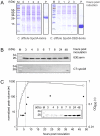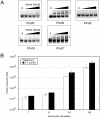C. difficile 630Δerm Spo0A regulates sporulation, but does not contribute to toxin production, by direct high-affinity binding to target DNA
- PMID: 23119071
- PMCID: PMC3485338
- DOI: 10.1371/journal.pone.0048608
C. difficile 630Δerm Spo0A regulates sporulation, but does not contribute to toxin production, by direct high-affinity binding to target DNA
Abstract
Clostridium difficile is a Gram positive, anaerobic bacterium that can form highly resistant endospores. The bacterium is the causative agent of C. difficile infection (CDI), for which the symptoms can range from a mild diarrhea to potentially fatal pseudomembranous colitis and toxic megacolon. Endospore formation in Firmicutes, including C. difficile, is governed by the key regulator for sporulation, Spo0A. In Bacillus subtilis, this transcription factor is also directly or indirectly involved in various other cellular processes. Here, we report that C. difficile Spo0A shows a high degree of similarity to the well characterized B. subtilis protein and recognizes a similar binding sequence. We find that the laboratory strain C. difficile 630Δerm contains an 18bp-duplication near the DNA-binding domain compared to its ancestral strain 630. In vitro binding assays using purified C-terminal DNA binding domain of the C. difficile Spo0A protein demonstrate direct binding to DNA upstream of spo0A and sigH, early sporulation genes and several other putative targets. In vitro binding assays suggest that the gene encoding the major clostridial toxin TcdB may be a direct target of Spo0A, but supernatant derived from a spo0A negative strain was no less toxic towards Vero cells than that obtained from a wild type strain, in contrast to previous reports. These results identify for the first time direct (putative) targets of the Spo0A protein in C. difficile and make a positive effect of Spo0A on production of the large clostridial toxins unlikely.
Conflict of interest statement
Figures




References
-
- Errington J (2003) Regulation of endospore formation in Bacillus subtilis . Nat Rev Microbiol 1: 117–126. 10.1038/nrmicro750 [doi]. - PubMed
-
- Paredes CJ, Alsaker KV, Papoutsakis ET (2005) A comparative genomic view of clostridial sporulation and physiology. Nat Rev Microbiol 3: 969–978. nrmicro1288 [pii];10.1038/nrmicro1288 [doi]. - PubMed
-
- Bird TH, Grimsley JK, Hoch JA, Spiegelman GB (1993) Phosphorylation of Spo0A activates its stimulation of in vitro transcription from the Bacillus subtilis spoIIG operon. Mol Microbiol 9: 741–749. - PubMed
Publication types
MeSH terms
Substances
Associated data
- Actions
LinkOut - more resources
Full Text Sources
Other Literature Sources
Molecular Biology Databases

